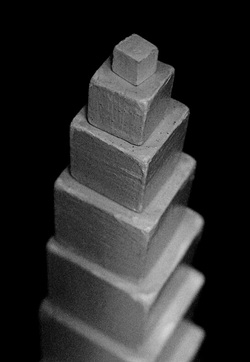The Montessori Advantage

The Schedule
The traditional school schedule is broken into a series of 40-minute periods, with every student in a class doing the same work at the same time. A hallmark of the Montessori classroom, on the other hand, is an extended, uninterrupted, work period each day, often as long a three hours, not broken up by required group lessons. During this time, older children schedule meetings or study groups with each other or with the teacher when necessary. Adults and children respect concentration and do not interrupt someone who is busy at a task. Groups form spontaneously or are arranged ahead by special appointment. They almost never take precedence over self-selected work.
Multi-age Grouping
Traditional classrooms are made up of children born within one year of one another. In such an environment, your birthday is your destiny: if you are the youngest child in your class, you will always be the youngest. Children in Montessori classrooms are grouped in mixed ages and abilities in three-year spans: 3-6, 6-9, 9-12, and 12-14. Children who were once among the youngest in the class will, in two years, be among the oldest. As in a family, this allows children to try on different roles and to learn from one another, not just from the teacher. There is constant interaction, problem solving, child-to-child teaching, and socialization. Children are challenged according to their ability.
Classroom Environment
Classrooms, students sit at desks or, in some schools, at tables of four to six students. And that is where they stay for most of the day. The Montessori classroom environment is arranged according to subject area, and children are free to move around the room as they wish. There are a variety of work areas, including comfortable chairs for reading, child-sized tables and chairs, spaces for group and individual work. Under the careful guidance of their teachers, children choose where and with what materials they work. There is no limit to how long a child can work with a piece of material. At any given time in a school day the full range of academic subjects are available for study - math, language, science, history, geography - as students desire to satisfy their innate curiosity.
Teaching Method
Assessments drive the traditional classroom, while mastery learning drives the Montessori classroom. The child's effort and work is respected, and the teacher, through extensive observation and record-keeping, plans individual projects to enable each child to learn what she needs in order to progress.
The traditional school schedule is broken into a series of 40-minute periods, with every student in a class doing the same work at the same time. A hallmark of the Montessori classroom, on the other hand, is an extended, uninterrupted, work period each day, often as long a three hours, not broken up by required group lessons. During this time, older children schedule meetings or study groups with each other or with the teacher when necessary. Adults and children respect concentration and do not interrupt someone who is busy at a task. Groups form spontaneously or are arranged ahead by special appointment. They almost never take precedence over self-selected work.
Multi-age Grouping
Traditional classrooms are made up of children born within one year of one another. In such an environment, your birthday is your destiny: if you are the youngest child in your class, you will always be the youngest. Children in Montessori classrooms are grouped in mixed ages and abilities in three-year spans: 3-6, 6-9, 9-12, and 12-14. Children who were once among the youngest in the class will, in two years, be among the oldest. As in a family, this allows children to try on different roles and to learn from one another, not just from the teacher. There is constant interaction, problem solving, child-to-child teaching, and socialization. Children are challenged according to their ability.
Classroom Environment
Classrooms, students sit at desks or, in some schools, at tables of four to six students. And that is where they stay for most of the day. The Montessori classroom environment is arranged according to subject area, and children are free to move around the room as they wish. There are a variety of work areas, including comfortable chairs for reading, child-sized tables and chairs, spaces for group and individual work. Under the careful guidance of their teachers, children choose where and with what materials they work. There is no limit to how long a child can work with a piece of material. At any given time in a school day the full range of academic subjects are available for study - math, language, science, history, geography - as students desire to satisfy their innate curiosity.
Teaching Method
Assessments drive the traditional classroom, while mastery learning drives the Montessori classroom. The child's effort and work is respected, and the teacher, through extensive observation and record-keeping, plans individual projects to enable each child to learn what she needs in order to progress.
|
Montessori Education
|
Traditional Education
|
